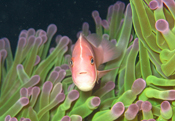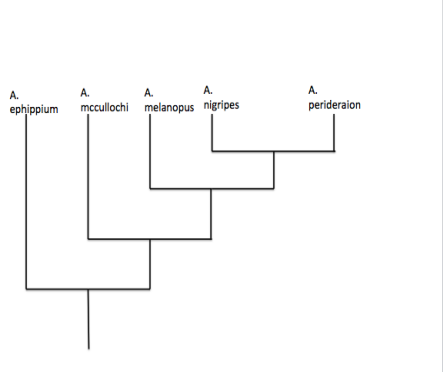Classification
Amphiprion perideraion is the scientific
classification given to this particular type of clown fish.
But what does this mean? Before we break down how the species is
classified scientifically, let us take a look at what the name
means. Like most scientific names, they are derived from
old Latin language. Amphi is the greek meaning for
"both sided", and prion is the greek word for "saw"
(Florida Museum of Natural History, 1995). By looking at
the classification of the Amphiprion perideraion, you
will learn why it is classified as this, and how it is similiar
to other Amphiprions until it splits into its own species to
make the Pink Skunk Clownfish. The species common name
comes from where the fish is located around the world, as well
as what it looks like (Florida Museum of Natural History, 1995).

Domain: Opisthokont
Kingdom: Animalia
Phylum: Chordata
Class: Actinopterygii
Order: Perciformes
Family: Pomacentridea
Genus: Amphiprion
Species:perideraion
Opisthokont: The classification of Domain is the overall group or the big picture of where the organism is placed. For Opisthokonts, the two groups under this title are the Fungi and the Animals (EOL, 2009). Looking at how these groups of organisms are all multicellular, they share characteristics of having a flagellated life cycle stage where the flagellum is behind the cell as it “swims” (EOL, 2009).
Anamalia: This is the Kingdom that Amphiprion perideraion is under. All the species that are in this kingdom are multicellular (EOL, 2009). This is one of three kingdoms that is multicellular- the others being fungi and green plants (EOL, 2009). For the most part, organisms in Anamalia are animals that obtain their energy from consuming, parasitizing, or decomposing organic material. Basically, the animals receive energy and nutrients through other organisms (EOL, 2009). This group is extremely diverse.
Chordata: Chordata is the taxonomic ranking of division for the Pink Skunk Clownfish. To be in this division, all the animals at some stage in their lives have a notochord, a dorsal hollow nerve cord, a post anal muscular tail, and pharyngeal gill slits (EOL, 2009). The organisms can have simple body plans, or more complex structures like the Amphiprion perideraion which is considered a vertebrate (EOL 2009).
Actinopterygii: With being a vertebrate, under the Actinopterygii class the Amphiprion perideraion is a “ray-finned fish” (EOL, 2009). This particular class of fishes make up half of the living vertebrate, deeming them quite successful (EOL, 2009). These ray-finned fish have fin rays (lepidotrichia) that are basically bony spines that are held together by epidermal tissue (EOL, 2009).
Perciformes: This title comes from the Greek language of “perch-like” fish (EOL, 2009). This group is the largest order of fish, and is considered the most dominant vertebrates in the oceans (EOL, 2009). This order is extremely divers, and can be found almost everywhere from fresh to marine habitats (EOL, 2009). The Amphiprion perideraion is a marine fish and is found near coral reefs. Characteristics that are shared under this order are side pectoral fins, dorsal and anal spines, and a jaw that can thrust forward (EOL, 2009).
Pomacentridea: Following the classification pattern of being extremely abundant among ocean dwellers, this family is widely spread and abundant among reef fishes (EOL, 2009). The characteristics are that Pomacentrids are small and brightly colored (which the Pink Skunk Clownfish is) and the common name is “damselfish" (EOL, 2009).
Amphiprion: With the genus, we start to get more specific on what our group of fish is classified under. Amphiprion is specifically for marine clownfish (EOL, 2009). The clownfish follow similar trends as living around reefs, or within a host species of sea anemones (EOL, 2009). Amphiprions are also known for their hierarchal groups when dealing with the way they reproduce (EOL, 2009).
perideraion: The species of classification is what would be considered the organisms first name. The genus is the last name, and therefore may cover several species under one genus. But only one species will have a unique combination of epiteth that destinguish it. There are distinct characteristics that group this fish in a singular title of Amphiprion perideraion. Characteristics such as being monogamous, hermaphroditic and having particular pairing tendencies when mating, living in symbiosis with a sea anemone, and how they lay and guard their eggs (EOL, 2009). It is these characteristics, combined with all the classification properties the precede this perideraion-species title that allow the Pink Skunk Clownfish to be an idiosyncratic group named Amphiprion perideraion.

Figure 1. The closest relatives to Amphiprion perideraion
based on physical characteristics of color stripping (Allen 1972)
Amphiprion perideraion has many close relatives that are also part of the same genus. These species are separated by differences in color patterns, fin shapes, and other physical characteristics. The phylogenic tree above displays some of these close relatives and how they are related to one another. The major differences that separate these species is the stripping on their bodies. Usually the three white stripes is what comes to mind, but none of these species have this stripping. Amphiprion perideraion has a stripe vertically across the top of the body. The species most closely related have little to no stripping and more turns into blobs of color marks on the bodies.

Figure 2. The spcecies Amphirprion perideraion is in the Phylum Chordata, a sister taxa of Echinodermata.
The Pink Skunk Clownfish is a part of the Major Clade Opisthokonta and in the Phylum Chordata. The phylogenetic tree shown above, describes the relationships between all of the Phylum in this clade and what causes the splits in the phylogeny. Deuterstome development refers to the embryonic development and that the two Phylum have the development of the anus first and the mouth second. Protostome development is the exact opposite, with the mouth developing first.
